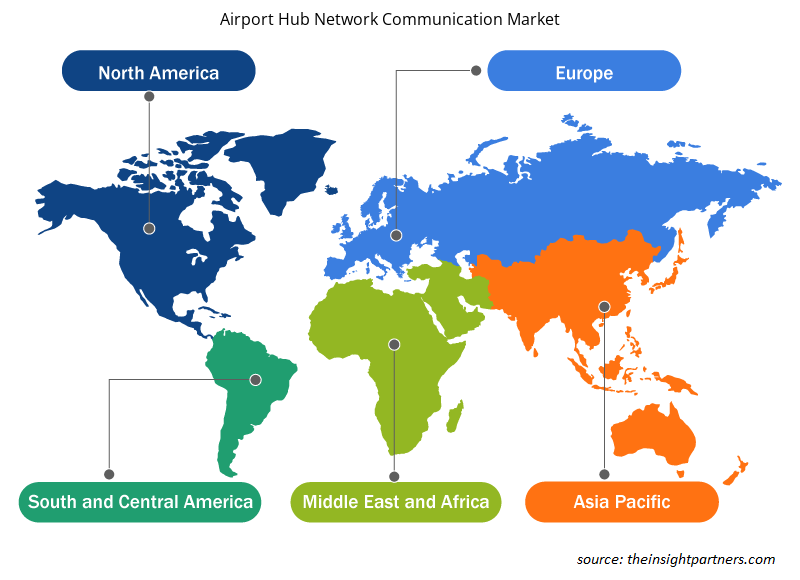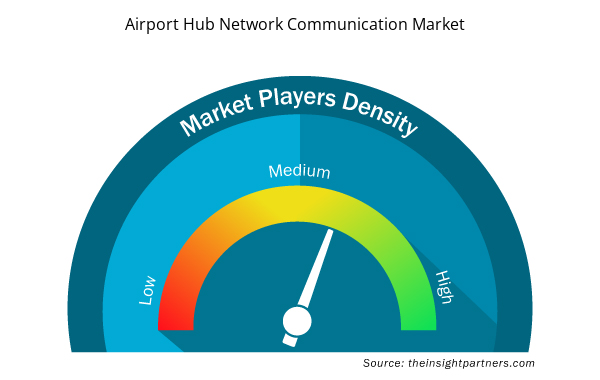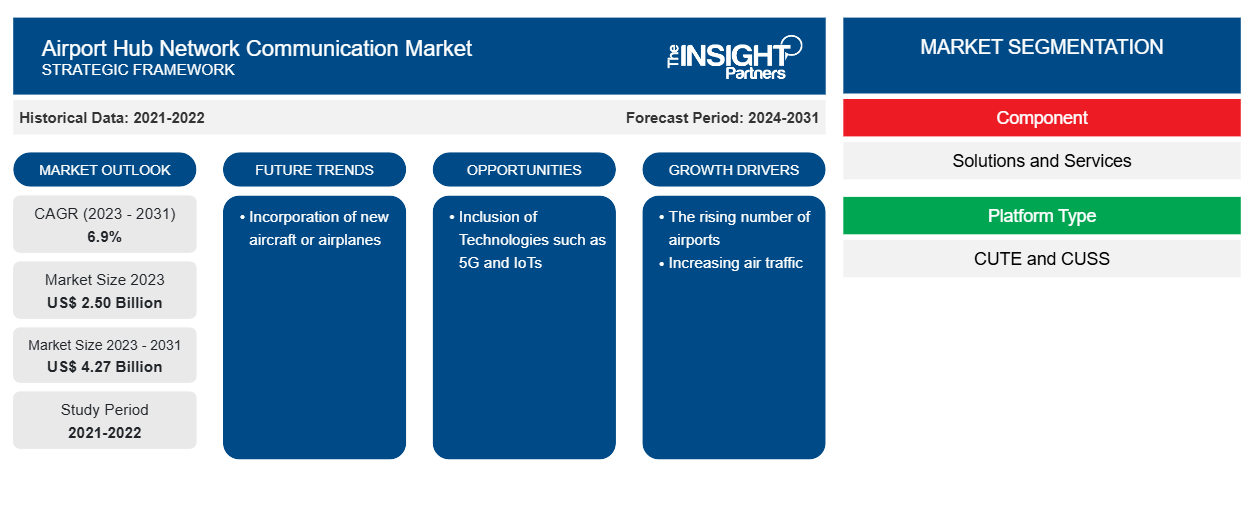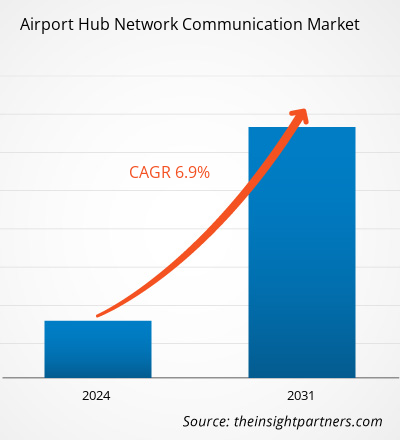Der Markt für Flughafen-Hub-Netzwerkkommunikation wird voraussichtlich von 2,50 Milliarden US-Dollar im Jahr 2023 auf 4,27 Milliarden US-Dollar im Jahr 2031 anwachsen. Der Markt wird zwischen 2023 und 2031 voraussichtlich eine durchschnittliche jährliche Wachstumsrate von 6,9 % verzeichnen. Die Einbindung neuer Flugzeuge oder Maschinen wird wahrscheinlich ein wichtiger Trend auf dem Markt bleiben.
Marktanalyse für Flughafen-Hub-Netzwerkkommunikation
Das Ökosystem des Flughafen-Hub-Netzwerkkommunikationsmarktes besteht aus Technologieentwicklern, Lösungs- und Serviceanbietern sowie Endbenutzern. Technologieanbieter bieten KI, IoT-basierte Software und entsprechende Softwareentwicklungskits an. Fluggesellschaften in der Luftfahrtbranche gehen aktiv Partnerschaften mit Technologieanbietern ein, um ein Kommunikationsnetzwerk mit Fluggesellschaften und Flughäfen aufzubauen. Lösungs- und Serviceanbieter bieten verschiedene Arten von Diensten an, wie KI, IoT-basierte Software, CUSS- und CUTE-Plattformen, Internetdienste und andere Dienste im Zusammenhang mit der Kommunikation in Fluggesellschaften und Flughäfen.
Marktübersicht für Flughafen-Hub-Netzwerkkommunikation
Die Anbieter von Kommunikationslösungen und -diensten für Flughafen-Hubs sind Schlüsselelemente des Marktes für Netzwerkkommunikation für Flughafen-Hubs. Diese Akteure sind an den meisten Aktivitäten des Marktes für Flughafen-Hub-Kommunikation beteiligt, beispielsweise an der Bereitstellung von Diensten und Lösungen für Flughäfen und Fluggesellschaften. Die wichtigsten Akteure auf dem Markt sind Honeywell International Inc, SITA Switzerland SaRl, Amazon Web Services, Collins Aerospace, Amadeus IT Group SA, Embross Systems Pvt Ltd, Materna IPS GmbH, TAV Technologies Ltd, Cisco Systems Inc. und Telefonaktiebolaget LM Ericsson. Verschiedene Luftfahrtunternehmen auf der ganzen Welt sind die Endnutzer des Marktes für Netzwerkkommunikation für Flughafen-Hubs und haben daher einen erheblichen Anteil am Marktwachstum.
Passen Sie diesen Bericht Ihren Anforderungen an
Sie erhalten kostenlose Anpassungen an jedem Bericht, einschließlich Teilen dieses Berichts oder einer Analyse auf Länderebene, eines Excel-Datenpakets sowie tolle Angebote und Rabatte für Start-ups und Universitäten.
- Holen Sie sich die wichtigsten Markttrends aus diesem Bericht.Dieses KOSTENLOSE Beispiel umfasst eine Datenanalyse von Markttrends bis hin zu Schätzungen und Prognosen.
Markttreiber und Chancen für die Netzwerkkommunikation an Flughafen-Hubs
Zunehmender Flugverkehr
Die Urbanisierungsraten nehmen weltweit zu. Laut dem Minister für Zivilluftfahrt und Stahl wird beispielsweise die Urbanisierung Indiens voraussichtlich von 34,9 % im Jahr 2020 auf 40 % im Jahr 2030 ansteigen. Aufgrund der stärkeren Urbanisierung steigt das verfügbare Einkommen der Menschen, was zu höheren Ausgaben der Menschen geführt hat. Laut der International Air Transport Association (IATA) beispielsweise stieg der weltweite Flugverkehr im Januar 2023 im Vergleich zum Januar 2022 um 67,0 %. Darüber hinaus wuchs der Flugverkehr im Januar 2023 im Vergleich zum Januar 2019 um 84,2 %. Mehr Flugverkehr führt zu einer höheren Anzahl von Flugoperationen weltweit. Darüber hinaus steigt mit dem Anstieg des E-Commerce und des Welthandels weltweit die Nachfrage nach Lufttransporten für den Gütertransport, um den Anforderungen von Unternehmen und Verbrauchern nach schnellen Lieferungen gerecht zu werden. Darüber hinaus wird laut Boeings Commercial Market Outlook (CMO) 2022–2041 erwartet, dass der Luftfrachtverkehr zwischen 2022 und 2041 um 3,8 % wachsen wird.
Einbeziehung von Technologien wie 5G und IoTs
Laut IATA wird die Zahl der Flugreisenden bis 2037 voraussichtlich 8,2 Milliarden erreichen. Erhöhter Flugverkehr führt auch zu mehr Flügen, wobei die Kommunikation zwischen Flughafen und Fluglinienbehörden für einen effizienten Flughafenbetrieb und ein effizientes Flugmanagement unverzichtbar ist . Angesichts der steigenden Zahl an Fluggästen muss der Luftfahrtsektor umfassend gerüstet sein, um dieses erhöhte Flugaufkommen zu bewältigen. Flughäfen und Fluggesellschaften benötigen daher leistungsstarke Lösungen wie Flughafen 4.0 oder Flughafendigitalisierung, um die steigenden Passagierzahlen bewältigen zu können. IoT-Konnektivität in den Flughafen-Hubs ermöglicht es ihnen, ihre vorhandenen oder neuen Hardwaresysteme mit dem Internet zu verbinden und so zu mehr Transparenz, Konnektivität, vereinfachten Arbeitsabläufen und besserer Kommunikation zwischen den Fluggesellschaften und den Flughafenbehörden beizutragen. Verbesserte Konnektivität bietet darüber hinaus mehr Sicherheit und effizientere Arbeitsabläufe in allen Flugphasen, von der Ankunft bis zum Abflug.
Segmentierungsanalyse des Marktberichts zur Flughafen-Hub-Netzwerkkommunikation
Wichtige Segmente, die zur Ableitung der Marktanalyse für Flughafen-Hub-Netzwerkkommunikation beigetragen haben, sind Komponente, Plattformtyp, Konnektivitätstyp und Endbenutzer.
- Basierend auf den Komponenten ist der Markt für Flughafen-Hub-Netzwerkkommunikation in Lösungen und Dienste segmentiert. Das Dienstleistungssegment hatte im Jahr 2023 einen größeren Marktanteil.
- Basierend auf der Plattform ist der Markt für Flughafen-Hub-Netzwerkkommunikation in CUTE und CUSS segmentiert. Das CUTE-Segment hatte im Jahr 2023 einen größeren Marktanteil.
- Basierend auf dem Verbindungstyp ist der Markt für Flughafen-Hub-Netzwerkkommunikation in Internet und MPLS segmentiert. Das MPLS-Segment hatte im Jahr 2023 einen größeren Marktanteil.
- Basierend auf den Endnutzern ist der Markt für Flughafen-Hub-Netzwerkkommunikation in Fluggesellschaften und Flughäfen segmentiert. Das Segment Flughäfen hatte im Jahr 2023 einen größeren Marktanteil. Darüber hinaus wurde das Segment Fluggesellschaften weiter in Passagier- und Frachtverkehr unterteilt. Auch das Segment Flughäfen wurde weiter in Klasse I, Klasse II, Klasse III und Klasse IV unterteilt.
Marktanteilsanalyse für Flughafen-Hub-Netzwerkkommunikation nach geografischer Lage
Der geografische Umfang des Marktberichts zur Flughafen-Hub-Netzwerkkommunikation ist hauptsächlich in fünf Regionen unterteilt: Nordamerika, Europa, Asien-Pazifik, Naher Osten und Afrika sowie Südamerika.
Nordamerika dominierte den Markt im Jahr 2023, gefolgt von Europa und dem asiatisch-pazifischen Raum. Darüber hinaus dürfte der asiatisch-pazifische Raum in den kommenden Jahren die höchste durchschnittliche jährliche Wachstumsrate verzeichnen. Die USA hatten den größten Marktanteil am nordamerikanischen Markt für die Kommunikation von Flughafen-Hub-Netzwerken. Im Jahr 2021 gab der Airports Council International-North America an, dass US-Flughäfen bis 2026 Investitionen in Höhe von mehr als 115 Milliarden US-Dollar für ihre Entwicklung benötigen. Aufgrund der COVID-19-Pandemie wurden die Pläne zur Flughafenerweiterung jedoch unterbrochen. Das Land hat vor kurzem begonnen, nach Möglichkeiten zu suchen, sein Angebot an Luftfahrtdienstleistungen zu erweitern. Im Jahr 2022 kündigte die US-amerikanische Federal Aviation Administration (FAA) Pläne an, im Jahr 2023 im Rahmen des Infrastructure Investment and Jobs Act (IIJA) 1 Milliarde US-Dollar für flughafenbezogene Projekte über einen Zeitraum von fünf Jahren zu investieren.CAGR in the coming years. The US accounted for the largest market share in North America airport hub network communication market. In 2021, the Airports Council International-North America stated that US airports require more than US$ 115 billion of investment for their development by 2026. However, due to the COVID-19 pandemic, the airport expansion plans were disrupted. The country has recently started looking for ways to expand its range of aviation services. In 2022, the US Federal Aviation Administration (FAA) announced plans of investing US $1 billion in 2023 for airport-related projects spanning five years under the Infrastructure Investment and Jobs Act (IIJA).
Regionale Einblicke in den Markt für Flughafen-Hub-Netzwerkkommunikation
Die regionalen Trends und Faktoren, die den Markt für Flughafen-Hub-Netzwerkkommunikation während des gesamten Prognosezeitraums beeinflussen, wurden von den Analysten von Insight Partners ausführlich erläutert. In diesem Abschnitt werden auch Marktsegmente und Geografien für Flughafen-Hub-Netzwerkkommunikation in Nordamerika, Europa, im asiatisch-pazifischen Raum, im Nahen Osten und Afrika sowie in Süd- und Mittelamerika erörtert.

- Erhalten Sie regionale Daten zum Markt für Flughafen-Hub-Netzwerkkommunikation
Umfang des Marktberichts zur Flughafen-Hub-Netzwerkkommunikation
| Berichtsattribut | Details |
|---|---|
| Marktgröße im Jahr 2023 | 2,50 Milliarden US-Dollar |
| Marktgröße bis 2031 | 4,27 Milliarden US-Dollar |
| Globale CAGR (2023 - 2031) | 6,9 % |
| Historische Daten | 2021-2022 |
| Prognosezeitraum | 2024–2031 |
| Abgedeckte Segmente | Nach Komponente
|
| Abgedeckte Regionen und Länder | Nordamerika
|
| Marktführer und wichtige Unternehmensprofile |
|
Dichte der Marktteilnehmer für die Netzwerkkommunikation an Flughafen-Hubs: Auswirkungen auf die Geschäftsdynamik verstehen
Der Markt für Flughafen-Hub-Netzwerkkommunikation wächst rasant, angetrieben durch die steigende Endnutzernachfrage aufgrund von Faktoren wie sich entwickelnden Verbraucherpräferenzen, technologischen Fortschritten und einem größeren Bewusstsein für die Vorteile des Produkts. Mit steigender Nachfrage erweitern Unternehmen ihr Angebot, entwickeln Innovationen, um die Bedürfnisse der Verbraucher zu erfüllen, und nutzen neue Trends, was das Marktwachstum weiter ankurbelt.
Die Marktteilnehmerdichte bezieht sich auf die Verteilung der Firmen oder Unternehmen, die in einem bestimmten Markt oder einer bestimmten Branche tätig sind. Sie gibt an, wie viele Wettbewerber (Marktteilnehmer) in einem bestimmten Marktraum im Verhältnis zu seiner Größe oder seinem gesamten Marktwert präsent sind.
Die wichtigsten auf dem Markt für Flughafen-Hub-Netzwerkkommunikation tätigen Unternehmen sind:
- Honeywell International Inc
- SITA Switzerland SaRl
- Amazon Web Services Inc
- Collins Luft- und Raumfahrt
- Amadeus IT Group SA
- Embross Systems Pvt Ltd
Haftungsausschluss : Die oben aufgeführten Unternehmen sind nicht in einer bestimmten Reihenfolge aufgeführt.

- Überblick über die wichtigsten Akteure auf dem Markt für Flughafen-Hub-Netzwerkkommunikation
Nachrichten und aktuelle Entwicklungen zum Flughafen-Hub-Netzwerkkommunikationsmarkt
Der Markt für Flughafen-Hub-Netzwerkkommunikation wird durch die Erfassung qualitativer und quantitativer Daten nach Primär- und Sekundärforschung bewertet, die wichtige Unternehmensveröffentlichungen, Verbandsdaten und Datenbanken umfasst. Nachfolgend sind einige der Entwicklungen auf dem Markt für Flughafen-Hub-Netzwerkkommunikation aufgeführt:
- SITA setzt in Zusammenarbeit mit dem Reiseidentitätsunternehmen Zamna Technologies auf Innovationen mit Spitzentechnologie, um seine Lösungen für Fluggesellschaften, Flughäfen und Grenzen zu stärken. Die Lösung von Zamna verwendet ein dezentrales Blockchain-basiertes Modell, um die Überprüfung und Handhabung von Passagierdaten wie Reisepässen, Visa und Gesundheitsinformationen zu verändern und so Reisenden, Fluggesellschaften, Flughäfen und Regierungen mehr Sicherheit, Komfort und Effizienz zu bieten. (Quelle: SITA, Pressemitteilung, Januar 2023)
- Die neue Partnerschaft zwischen Etihad Cargo und SF Airlines bietet den Kunden von Etihad Cargo eine bessere Anbindung an 25 Inlandsziele in China über das Lkw-Zubringernetz von SF Airlines und erweitert damit die Kapazitäten von Etihad Cargo in der Region. (Quelle: Etihad, Pressemitteilung, Juni 2023)
Marktbericht zur Netzwerkkommunikation an Flughäfen und deren Ergebnisse
Der Bericht „Marktgröße und Prognose für Flughafen-Hub-Netzwerkkommunikation (2021–2031)“ bietet eine detaillierte Analyse des Marktes, die die folgenden Bereiche abdeckt:
- Marktgröße und Prognose für die Flughafen-Hub-Netzwerkkommunikation auf globaler, regionaler und Länderebene für alle wichtigen Marktsegmente, die im Rahmen des Berichts abgedeckt sind
- Markttrends für die Netzwerkkommunikation an Flughafenknotenpunkten sowie Marktdynamiken wie Treiber, Einschränkungen und wichtige Chancen
- Detaillierte Porter-Fünf-Kräfte-Analyse
- Marktanalyse für Flughafen-Hub-Netzwerkkommunikation mit wichtigen Markttrends, globalen und regionalen Rahmenbedingungen, wichtigen Akteuren, Vorschriften und aktuellen Marktentwicklungen
- Branchenlandschaft und Wettbewerbsanalyse, die die Marktkonzentration, Heatmap-Analyse, prominente Akteure und aktuelle Entwicklungen für den Markt für Flughafen-Hub-Netzwerkkommunikation umfasst
- Detaillierte Firmenprofile
- Historische Analyse (2 Jahre), Basisjahr, Prognose (7 Jahre) mit CAGR
- PEST- und SWOT-Analyse
- Marktgröße Wert/Volumen – Global, Regional, Land
- Branche und Wettbewerbsumfeld
- Excel-Datensatz



Report Coverage
Revenue forecast, Company Analysis, Industry landscape, Growth factors, and Trends

Segment Covered
This text is related
to segments covered.

Regional Scope
North America, Europe, Asia Pacific, Middle East & Africa, South & Central America

Country Scope
This text is related
to country scope.
Häufig gestellte Fragen
The airport hub network communication market is likely to register of 6.9% during 2023-2031.
The estimated value of the airport hub network communication market by 2031 would be around US$ 4.27 billion.
Incorporation of new aircraft or airplanes is one of the major trends of the market.
Honeywell International Inc, SITA Switzerland SaRl, Amazon Web Services Inc, Collins Aerospace, Amadeus IT Group SA, Embross Systems Pvt Ltd, Materna IPS GmbH, ADB Safegate BV, TAV Technologies Ltd, and Cisco Systems Inc are some of the key players profiled under the report.
The rising number of airports and increasing air traffic are some of the factors driving the growth for airport hub network communication market.
North America region dominated the airport hub network communication market in 2023.
Trends and growth analysis reports related to Aerospace and Defense : READ MORE..
The Insight Partners performs research in 4 major stages: Data Collection & Secondary Research, Primary Research, Data Analysis and Data Triangulation & Final Review.
- Data Collection and Secondary Research:
As a market research and consulting firm operating from a decade, we have published and advised several client across the globe. First step for any study will start with an assessment of currently available data and insights from existing reports. Further, historical and current market information is collected from Investor Presentations, Annual Reports, SEC Filings, etc., and other information related to company’s performance and market positioning are gathered from Paid Databases (Factiva, Hoovers, and Reuters) and various other publications available in public domain.
Several associations trade associates, technical forums, institutes, societies and organization are accessed to gain technical as well as market related insights through their publications such as research papers, blogs and press releases related to the studies are referred to get cues about the market. Further, white papers, journals, magazines, and other news articles published in last 3 years are scrutinized and analyzed to understand the current market trends.
- Primary Research:
The primarily interview analysis comprise of data obtained from industry participants interview and answers to survey questions gathered by in-house primary team.
For primary research, interviews are conducted with industry experts/CEOs/Marketing Managers/VPs/Subject Matter Experts from both demand and supply side to get a 360-degree view of the market. The primary team conducts several interviews based on the complexity of the markets to understand the various market trends and dynamics which makes research more credible and precise.
A typical research interview fulfils the following functions:
- Provides first-hand information on the market size, market trends, growth trends, competitive landscape, and outlook
- Validates and strengthens in-house secondary research findings
- Develops the analysis team’s expertise and market understanding
Primary research involves email interactions and telephone interviews for each market, category, segment, and sub-segment across geographies. The participants who typically take part in such a process include, but are not limited to:
- Industry participants: VPs, business development managers, market intelligence managers and national sales managers
- Outside experts: Valuation experts, research analysts and key opinion leaders specializing in the electronics and semiconductor industry.
Below is the breakup of our primary respondents by company, designation, and region:

Once we receive the confirmation from primary research sources or primary respondents, we finalize the base year market estimation and forecast the data as per the macroeconomic and microeconomic factors assessed during data collection.
- Data Analysis:
Once data is validated through both secondary as well as primary respondents, we finalize the market estimations by hypothesis formulation and factor analysis at regional and country level.
- Macro-Economic Factor Analysis:
We analyse macroeconomic indicators such the gross domestic product (GDP), increase in the demand for goods and services across industries, technological advancement, regional economic growth, governmental policies, the influence of COVID-19, PEST analysis, and other aspects. This analysis aids in setting benchmarks for various nations/regions and approximating market splits. Additionally, the general trend of the aforementioned components aid in determining the market's development possibilities.
- Country Level Data:
Various factors that are especially aligned to the country are taken into account to determine the market size for a certain area and country, including the presence of vendors, such as headquarters and offices, the country's GDP, demand patterns, and industry growth. To comprehend the market dynamics for the nation, a number of growth variables, inhibitors, application areas, and current market trends are researched. The aforementioned elements aid in determining the country's overall market's growth potential.
- Company Profile:
The “Table of Contents” is formulated by listing and analyzing more than 25 - 30 companies operating in the market ecosystem across geographies. However, we profile only 10 companies as a standard practice in our syndicate reports. These 10 companies comprise leading, emerging, and regional players. Nonetheless, our analysis is not restricted to the 10 listed companies, we also analyze other companies present in the market to develop a holistic view and understand the prevailing trends. The “Company Profiles” section in the report covers key facts, business description, products & services, financial information, SWOT analysis, and key developments. The financial information presented is extracted from the annual reports and official documents of the publicly listed companies. Upon collecting the information for the sections of respective companies, we verify them via various primary sources and then compile the data in respective company profiles. The company level information helps us in deriving the base number as well as in forecasting the market size.
- Developing Base Number:
Aggregation of sales statistics (2020-2022) and macro-economic factor, and other secondary and primary research insights are utilized to arrive at base number and related market shares for 2022. The data gaps are identified in this step and relevant market data is analyzed, collected from paid primary interviews or databases. On finalizing the base year market size, forecasts are developed on the basis of macro-economic, industry and market growth factors and company level analysis.
- Data Triangulation and Final Review:
The market findings and base year market size calculations are validated from supply as well as demand side. Demand side validations are based on macro-economic factor analysis and benchmarks for respective regions and countries. In case of supply side validations, revenues of major companies are estimated (in case not available) based on industry benchmark, approximate number of employees, product portfolio, and primary interviews revenues are gathered. Further revenue from target product/service segment is assessed to avoid overshooting of market statistics. In case of heavy deviations between supply and demand side values, all thes steps are repeated to achieve synchronization.
We follow an iterative model, wherein we share our research findings with Subject Matter Experts (SME’s) and Key Opinion Leaders (KOLs) until consensus view of the market is not formulated – this model negates any drastic deviation in the opinions of experts. Only validated and universally acceptable research findings are quoted in our reports.
We have important check points that we use to validate our research findings – which we call – data triangulation, where we validate the information, we generate from secondary sources with primary interviews and then we re-validate with our internal data bases and Subject matter experts. This comprehensive model enables us to deliver high quality, reliable data in shortest possible time.


 Holen Sie sich ein kostenloses Muster für diesen Bericht
Holen Sie sich ein kostenloses Muster für diesen Bericht